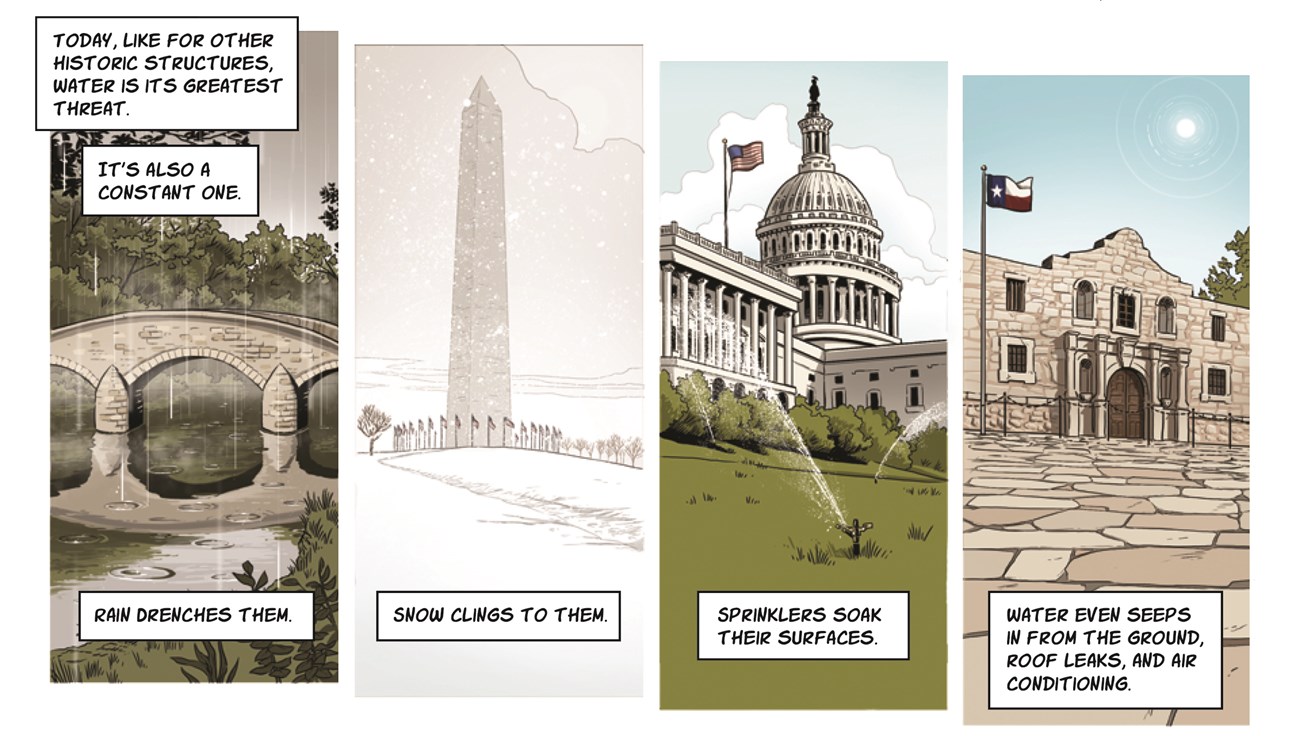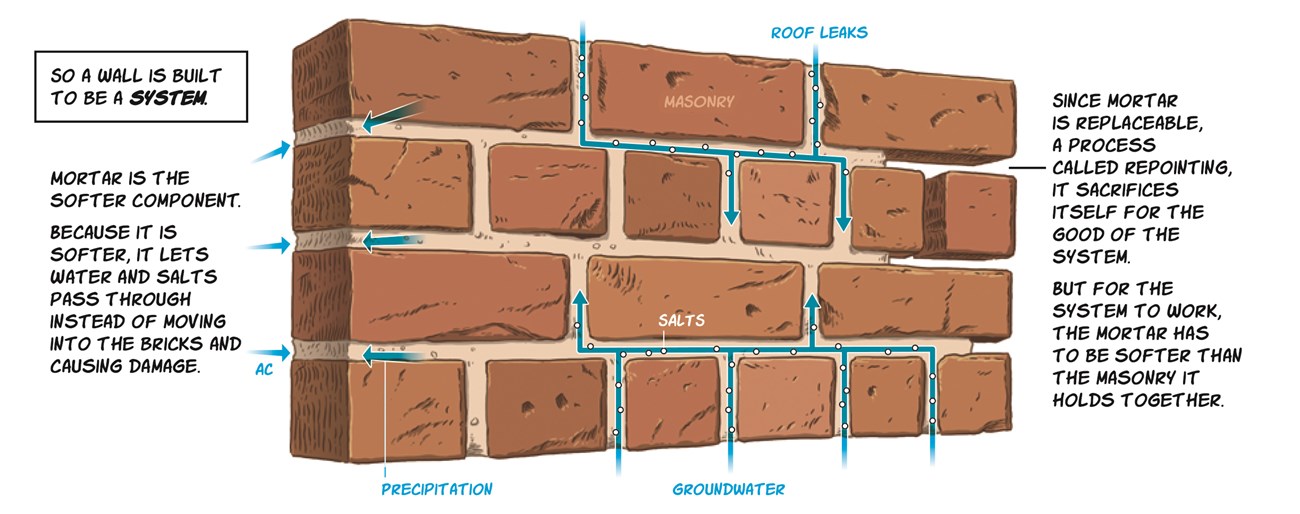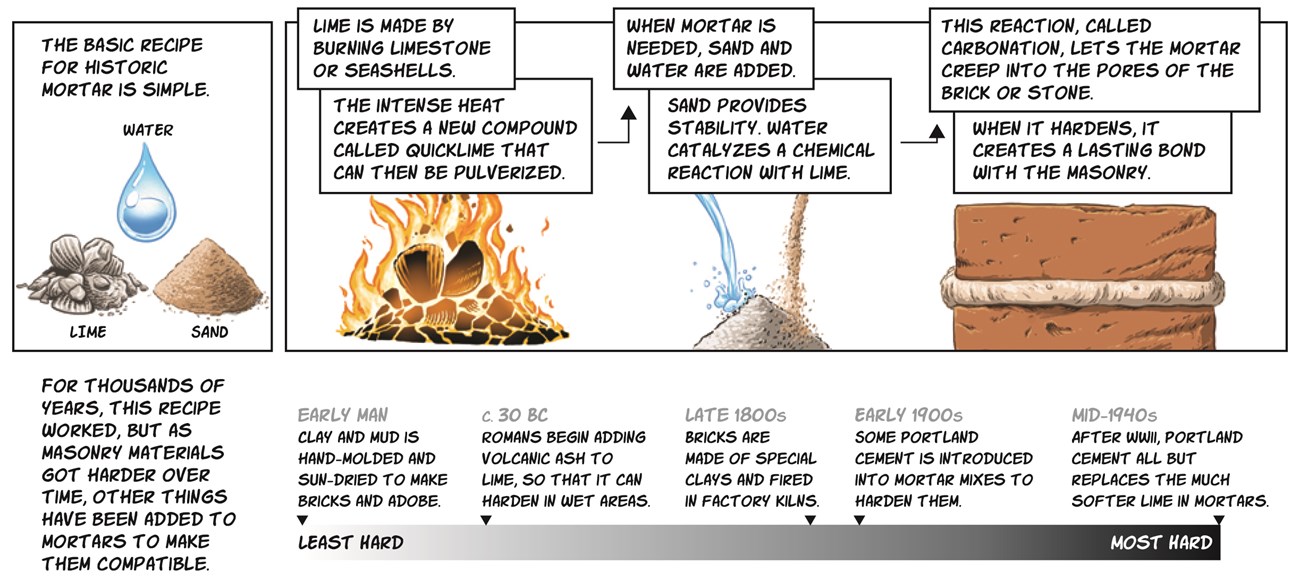Last updated: August 30, 2024
Article
Mortar, Unsung Hero of History
By Johnna Rizzo and Matthew Twombly








Transcript and Image Description
Line 1: Today, like for other historic structures, water is its greatest threat. It’s also a constant one.Rain drenches them.
Snow clings to them.
Sprinklers soak their surfaces.
Water even seeps in from the ground, roof leaks, and air conditioning.
Image Description: Four vertical cells from left to right.
Trees in the background of a stone arch bridge over a river on a rainy day.
Washington Monument surrounded by a circle of flags and a field of snow during a snowstorm.
Sprinklers water a green lawn next to the U.S. Capital building.
Flagstone style walkway in front of the Alamo.
Line 2: When the salts it carries crystallize on the outside of buildings, they create a bloom called efflorescence.
When crystals form within the bricks’ pores, as they grow, they break down the bricks from the inside. This causes slices of masonry to peel off, a process called spalling.
(CRACK) If left unchecked, the salts and water can cause the brick and stone to crack and crumble.
Image Description: Three image cells from left to right
White patches on a red brick wall.
Faces of bricks crumbling off a red brick wall.
A whole brick and other chunks of brick falling off a red brick wall.
Line 3: So a wall is built to be a system.
Mortar is the softer component. Because it is softer, it lets water and salts pass through instead of moving into the bricks and causing damage.
Since mortar is replaceable, a process called repointing, it sacrifices itself for the good of the system.
But for the system to work, the mortar has to be softer than the masonry it holds together.
Image Description: A brick wall with blue arrows following mortar lines pointing in different directions.
Arrows with random white dots pointing downward from the top with text reading roof leaks.
Arrows pointing upward with random white dots with text reading groundwater. The text next to the dots read salts.
Arrows pointing from front toward the back with text reading precipitation.
Arrows pointing from back toward the front with text reading AC.
Line 4: The basic recipe for historic mortar is simple.
Water, lime, and sand.Lime is made by burning limestone or seashells. The intense heat creates a new compound called quicklime that can then be pulverized.
When mortar is needed, sand and water are added. Sand provides stability. Water catalyzes a chemical reaction with lime.
This reaction, called carbonation, lets the mortar creep into the pores of the brick or stone. When it hardens, it creates a lasting bond with the masonry.
Image Description: Four images in two cells from left to right.
A drop of water above a pile of gray shells next to a pile of sand.
Shells in an open fire.
Water and sand being poured on to a gray pile.
A line of mortar sandwiched between two bricks.
Text: For thousands of years, this recipe worked, but as masonry materials got harder over time, other things have been added to mortars to make them compatible.
Least Hard
Early Man clay and mud is hand-molded and sun-dried to make bricks and adobe.
c 30 bc romans begin adding volcanic ash to lime, so that it can harden in wet areas.
Late 1800s bricks are made of special clays and fired in facory kilns.
Early 1900s some Portland cement is introduced into mortar mixes to harden them.
Most Hard
Mid-1940s after WWII, Portland cement all but replaces the much softer lime in mortars.
Image Description: Text to the left and above a bar scale light gray on the left (least hard) darkening to black on the right (most hard).
Line 5: Soft historic masonry and hard modern mortar is a catastrophic mix.
Image Description: A trowel with a large amount of mortar and a hand holding a small amount of mortar in the foreground. A red brick wall missing lines of mortar in the background.
Line 6: When mortar needs replacing, careful consideration of materials is required if we want these American icons to last.
Image Description: People standing in the middle of a lawn inside brick arches in the wall in the background. A portion of a brick arch and cannon in the foreground.
National Park Service Arrowhead and NCPTT logo superimposed in lower left corner.
Source: National Center for Preservation Technology and Training, National Park Service.
